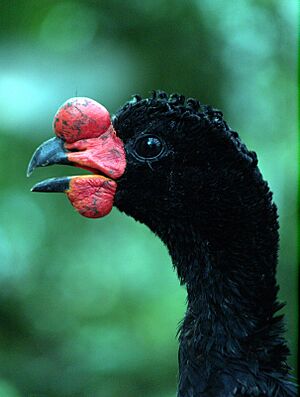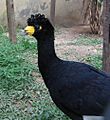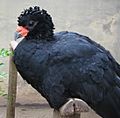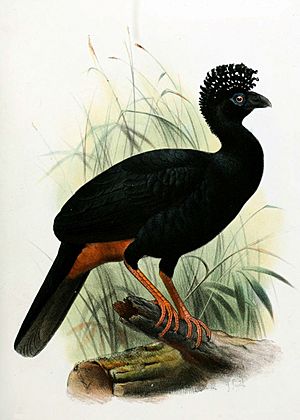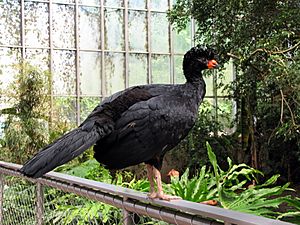Wattled curassow facts for kids
Quick facts for kids Wattled curassow |
|
|---|---|
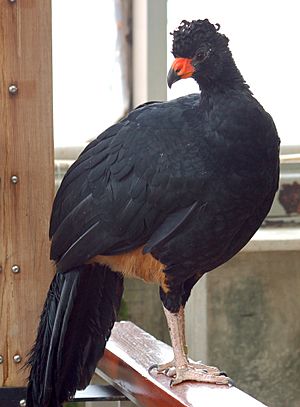 |
|
| Female at the National Aviary Note reddish-buff crissum (the area around the cloaca) |
|
| Conservation status | |
| Scientific classification | |
| Genus: |
Crax
|
| Species: |
globulosa
|
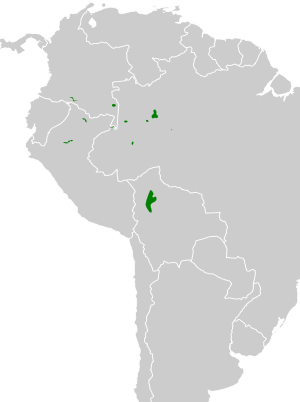 |
|
| Synonyms | |
|
Crax carunculata |
|
The wattled curassow (Crax globulosa) is a large bird that is currently threatened. It belongs to a bird family called Cracidae. This family includes curassows, guans, and chachalacas. You can find this bird in faraway rainforests in the western Amazon basin of South America.
Male wattled curassows have black plumage (feathers). They have a white area around their cloaca (called the crissum). Their heads have curly feathers, and they have red bill decorations and wattles. Females and young birds look similar to males. However, they do not have the bill decorations. Their crissum area is a reddish-buff color.
The wattled curassow lives in forests along rivers and in areas that flood during certain seasons. They usually eat in small groups on the ground. Their diet is mostly fruit. But they also eat small invertebrates (like insects) and sometimes small vertebrates. We do not know much about how they raise their young. But we do know that their nest is made of sticks and leaves. They usually lay two eggs.
The number of these birds is going down. They are in danger because their habitat is shrinking. Rainforests are being cut down, and people also hunt these birds. Because of this, the International Union for Conservation of Nature says the wattled curassow is an "endangered" species.
Contents
What Does the Wattled Curassow Look Like?
The wattled curassow is about 82 to 89 centimeters (32 to 35 inches) long. It weighs around 2,500 grams (88 ounces). It is a large curassow bird. Unlike some other curassows, it does not have white tips on its tail feathers. The feathers on top of its head curl forward.
Male birds have black feathers all over their bodies. Only the area around their cloaca (the crissum) is white. Their eyes are dark brown. Their legs, feet, and bill are blackish. They have bright red decorations on their bill. There is a round red knob at the base of the upper part of the bill. Also, a small fleshy wattle hangs below the lower part of the bill.
Female birds also have black feathers, just like the males. But their crissum area is a reddish-buff color. Some females might have faint brownish patterns on their wing feathers. Their bills and eyes are blackish too. But their feet and legs are a grayish-flesh color. Females do not have the bill knob or wattles. The skin at the base of their bill is a bright orange-red. Young males have smaller facial decorations. These decorations are usually more yellowish, like those of females.
Baby curassows are covered in brown down (soft feathers) on top. They have whitish down underneath.
Birds That Look Similar
Adult wattled curassows look a lot like the red-billed curassow (C. blumenbachii). However, male red-billed curassows only have a small knob on their upper bill. Female red-billed curassows have blackish skin at the base of their bill. Their legs and feet are quite pale. Their wings often have clear chestnut brown patterns.
The black curassow (C. alector erythrognatha) is found north of the Solimões River. It has skin at the base of its bill like the female wattled curassow. But its bill is lighter. Both male and female black curassows have a white crissum.
Young male C. globulosa can be confused with yellow-knobbed curassows (C. daubentoni). But yellow-knobbed curassows have a white tail edge. They also have a yellow (not orange) wattle on their bill.
These similar species usually live in different areas. Only the black curassow (C. a. erythrognatha) lives near the wattled curassow's home.
-
Wattled curassow female
Note dark bill and orange cere -
Male great curassow (C. rubra)
-
Eastern black curassow (C. a. alector)
Note light bill. Cere is orange-red in western subspecies. -
Adult male yellow-knobbed curassow (C. daubentoni)
-
Adult male red-billed curassow (C. blumenbachii)
Note crimson cere and lack of pronounced bill knob
Where the Wattled Curassow Lives
This bird has been found in the western and southwestern Amazon Basin of Brazil. It also lives west towards the Andes mountains in southeastern Colombia, eastern Ecuador, Peru, and northern Bolivia. Its main living area is bordered by several rivers: the Caquetá-Japurá, Solimões, Amazon, and Madeira Rivers. It also lives up to about 300 meters (984 feet) high in the Andes foothills.
We do not know much about its exact distribution. Most sightings have been by people traveling along the rivers in its range.
The northern edge of its home range runs along the middle Amazon River (also called Solimões). In northern Peru, where the Marañón River meets the Amazon, the range continues upstream into eastern Amazonian Ecuador. It has been seen near the Yavarí and middle Napo Rivers. It might not live in Ecuador anymore. Also, it is mostly gone from Colombia, except for two small groups.
Towards the eastern edge of its range, near the Madeira River in Bolivia, the wattled curassow lives in scattered areas. These areas are around where the Madeira River's tributaries (smaller rivers) meet. In Brazil, the bird is only found in the wild in Amazonas state. It used to live in Rondônia too. It is found near the Juruá, Javary, and Japurá rivers. It also lives where the Solimões, Madeira, Rio Negro, and Purus Rivers meet.
Wattled Curassow Behavior and Life
We do not know much about the wattled curassow's favorite habitat. Some people have seen it in high ground rainforests. But it probably only stays there in large numbers during the wet season when lower areas are flooded. Most often, people see them in forests along rivers and streams. They also live in forests that flood seasonally, around lakes, and on river islands. These flooded forests seem to be very important for this bird, at least at certain times of the year.
Like other curassows, mated pairs likely protect their own area. Many seem to stay in the same place their whole lives. Young birds might move a short distance after they grow up, if their parents are still alive. But even then, they probably stay in the same general area, perhaps only a few kilometers from where they were born.
Like most Galliformes (a group of birds including chickens), the wattled curassow mostly eats plants. They also eat some small animals, usually invertebrates. This can include crustaceans and fish sometimes. But there is not much real information about their diet. When they look for food, they do not dig around on the ground as much as other Crax curassows. This might mean they prefer different foods, like fresh fruit instead of fallen seeds.
Reproduction and Life Cycle
We do not know when the wattled curassow breeds in the wild. People have seen them reproducing between June and August. But there are not many records. Like many rainforest birds, they might not have clear breeding and non-breeding seasons. Males try to attract females by walking around them and making loud booming calls.
Pairs probably stay together for many years, often for their whole lives, like other curassows. Sometimes, they might change partners. If males are hunted often (their loud calls make them easy to find), a surviving male might pair with more than one female.
Their nest is a simple, flat cup made of twigs and leaves. It is small compared to the bird. They build it off the ground in plants. Like all curassows, they usually lay two white eggs. These eggs are probably about 3.5 by 2.5 inches (89 by 64 millimeters). The eggs likely hatch in about 30 days.
Both parents take care of the young birds, which are precocial (meaning they are born quite developed). The young might become independent around one year old, or maybe earlier. However, it is also possible that few birds are ready to breed before they are two years old. This suggests that grown-up young birds might stay with or near their parents for another year or so. One bird lived for more than 20 years in captivity.
Conservation Status
The wattled curassow is now rarely seen in the wild. This is because of too much hunting and habitat destruction. We have not studied its status very well. But old and new records show that it is much rarer now than it was in the late 1800s. The species seems to have disappeared from Ecuador in the 1980s. But some groups still live in remote areas of other countries where it is known.
It is not common anywhere. The only place where you might see it often is along the Juruá River in Brazil. This is especially true in the Mamirauá Sustainable Development Reserve. It is also found in some numbers near San Marcos in Beni Department, Bolivia. It might live in places we have not explored yet. For example, its presence in Colombia was only proven around 1950. That was when a bird was shot in Caquetá Department. But any unknown groups are probably not large. And as soon as people start hunting with guns in an area, the wattled curassow is likely to be shot more often than it can reproduce.
There might be a little more than 10,000 adult C. globulosa left in the world. But if there are few other groups besides the known ones, there might be less than 5,000 birds in total, including young ones. There are some wattled curassows in zoos and other captive places. This captive group is quite large for a curassow species. The species sometimes breeds in captivity. But this is not enough to stop the decline in the wild. Also, it does not have much legal protection. It is not known to live in any protected area other than the Mamirauá Sustainable Development Reserve.
The IUCN used to classify the wattled curassow as a Vulnerable species. This meant its numbers had dropped and kept dropping by about one-third every ten years. This was mainly due to hunting and habitat destruction. It also meant that likely between 2,500 and 10,000 adults existed. But no more than 1,000 lived in any one small group. In 2010, this classification was changed. It is now listed as an Endangered species.
See also
In Spanish: Pavón carunculado para niños



